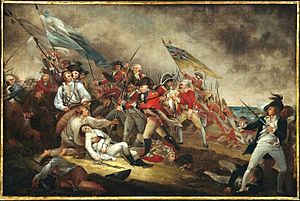John Pitcairn facts for kids
Quick facts for kids
John Pitcairn
|
|
|---|---|
 |
|
| Born | 28 December 1722 Dysart, Fife |
| Died | 17 June 1775 (aged 52) Boston, Massachusetts |
| Buried |
Old North Church, Boston
|
| Allegiance | |
| Service/ |
HM Marine Forces |
| Years of service | 1746–1775 |
| Rank | Major |
| Battles/wars | |
| Spouse(s) |
Elizabeth Dalrymple
(m. 1745) |
| Children | 9 (incl. Robert and David) |
John Pitcairn (born 1722, died 1775) was a British military officer. He was a Major in the Royal Marines. Pitcairn was born in Dysart, Fife, Scotland. He joined the British Naval Service when he was 23 years old. He served in North America during two big wars. These were the French and Indian War and the American Revolutionary War.
In 1774, he arrived in Boston as a major. He fought in the 1775 battles of Lexington and Concord. These battles started the American War of Independence. Two months later, in June, Pitcairn was killed. This happened during the Battle of Bunker Hill. Both his soldiers and his American enemies respected him. He was buried at Boston's Old North Church. When he died, his son Thomas was also a marine officer. Thomas helped carry his injured father from the battlefield.
Contents
Early Life and Joining the Marines
John Pitcairn was born in 1722. His hometown was Dysart, a port in Fife, Scotland. His parents were David and Katherine Pitcairn. His older brother, William, became a famous plant expert. William also led the Royal College of Physicians.
John joined the Marines when he was 23. He became a lieutenant in 1746. He served in Canada as a captain during the French and Indian War. In 1771, he was promoted to major. In 1774, he came to Boston, Massachusetts. He led 600 Marines. Their job was to support the royal governor, General Thomas Gage. The colony was becoming more and more rebellious.
A Respected Officer in Boston

People in Boston respected John Pitcairn. They saw him as one of the fairer officers. He was part of the group that marched on Lexington and Concord. This happened on April 19, 1775. This march started the American War of Independence.
During the march, his horse was shot. He also lost two matching pistols. These were lost when the army's supplies were left behind. A Patriot leader, Maj. Gen. Israel Putnam, used these pistols for the rest of the war.
His Final Battle: Bunker Hill
Two months later, the Battle of Bunker Hill took place. Major Pitcairn led about 300 Marines. They landed at the south end of the Charlestown peninsula. The first attacks did not work. So, Pitcairn led his men up the hill. They moved towards the American soldiers.
He had already been shot twice. But he still led his men through the rebel trenches. When he entered the trenches, he was shot four more times. He fell into the arms of his son, Thomas. Thomas was also a Marine officer. He cried out, "I have lost my father!" Some Marines tried to comfort the son. Others cried openly. Pitcairn was carried back to Boston. He died from his wounds within hours. He is buried at the Old North Church in Boston. After the battle, many Marines said they "had all lost a father."
A Hero's Farewell
John Trumbull painted a picture of the Battle of Bunker Hill. It shows Pitcairn's death. However, the painting has some mistakes. No known picture of Pitcairn exists. So, Trumbull used Pitcairn's son David as a model. The uniform Pitcairn wears in the painting was not used by Marines until the 1780s. The painting shows Pitcairn falling at the top of the hill. But he was actually shot as he started to climb the hill. Major Pitcairn is also in Trumbull's painting of the Battle of Lexington. This painting is in the U.S. Capitol rotunda.
His Family and Pitcairn Island
John Pitcairn married Elizabeth Dalrymple. They had five sons and four daughters. One son, Robert, was a midshipman in the Royal Navy. On July 3, 1767, he was on a ship called HMS Swallow. He was the first person to see an unknown island in the South Pacific. The captain named the island Pitcairn's Island to honor the boy. Later, in 1770, Robert Pitcairn was on another ship. This ship disappeared on its way to the Comoro Islands.
Another daughter, Catherine Pitcairn, married Charles Cochrane. Charles was the son of the 8th Earl of Dundonald. He was also a cousin of Admiral Thomas Cochrane, 10th Earl of Dundonald.
See also
 In Spanish: John Pitcairn para niños
In Spanish: John Pitcairn para niños

